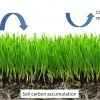Abstract
Native and improved pastures play an important role in sequestering carbon from the atmosphere. Because of the relatively high sequestration rates and extensive area, grazing land represents an important component of terrestrial carbon dioxide (CO2) offset and is a significant sink for long-term carbon sequestration and greenhouse gas mitigation. This 4-page fact sheet contains information for stakeholders, students, scientists, and environmental agencies interested in enhancing ecosystems services provided by grazing lands. Written by Maria Silveira, Ed Hanlon, Mariana Azenha, and Hiran M. da Silva, and published by the UF Department of Soil and Water Science, September 2012.
SL373/SS574: Carbon Sequestration in Grazing Land Ecosystems (ufl.edu)
References
Conant, R.T., K. Paustian, and E.T. Elliott. 2001. "Grassland Management and Conversion into Grassland Effects on Soil Carbon." Ecol. Appl. 11:343-55. https://doi.org/10.1890/1051-0761(2001)011[0343:GMACIG]2.0.CO;2
Eswaran, H., E. Van Den Berg, and P.F. Reich. 1993. "Organic Carbon in Soils of the World." Soil Sci. Soc. Am. J. 57: 192-4. https://doi.org/10.2136/sssaj1993.03615995005700010034x
Follett, R.F., J.M. Kimble, and R. Lal. 2001. The Potential of U.S. Grazing Lands to Sequester Carbon and Mitigate the Greenhouse Effect. Boca Raton, FL: Lewis Publishers. https://doi.org/10.1201/9781420032468.sec5
Schuman, G.E., D.R. LeCain, J.D. Reeder, and J.A. Morgan. 2001. "Carbon Dynamics and Sequestration of a Mixed-Grass Prairie as Influenced by Grazing." In Soil Carbon Sequestration and the Greenhouse Effect, special publication no. 57, edited by R. Lal, 67-75. Madison, WI: Soil Science Society of America.
Silveira, M.L., J.M. Vendramini, J.E. Rechcigl, and M.B. Adjei. 2009. Soil pH and Liming Issues Affecting Bahiagrass Pasture. SL292. Gainesville, FL: University of Florida Institute of Food and Agricultural Sciences. http://edis.ifas.ufl.edu/ss505. https://doi.org/10.32473/edis-ss505-2009

